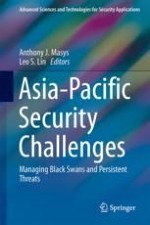This edited book examines the contemporary regional security concerns in the Asia-Pacific recognizing the ‘Butterfly effect’, the concept that small causes can have large effects: ‘the flap of a butterfly’s wings can cause a typhoon halfway around the world’.
For many Asia-Pacific states, domestic security challenges are at least as important as external security considerations. Recent events (both natural disasters and man-made disasters) have pointed to the inherent physical, economic, social and political vulnerabilities that exist in the region. Both black swan events and persistent threats to security characterize the challenges within the Asia-Pacific region.
Transnational security challenges such as global climate change, environmental degradation, pandemics, energy security, supply chain security, resource scarcity, terrorism and organized crime are shaping the security landscape regionally and globally. The significance of emerging transnational security challenges in the Asia-Pacific Region impact globally and conversely, security developments in those other regions affect the Asia-Pacific region.
